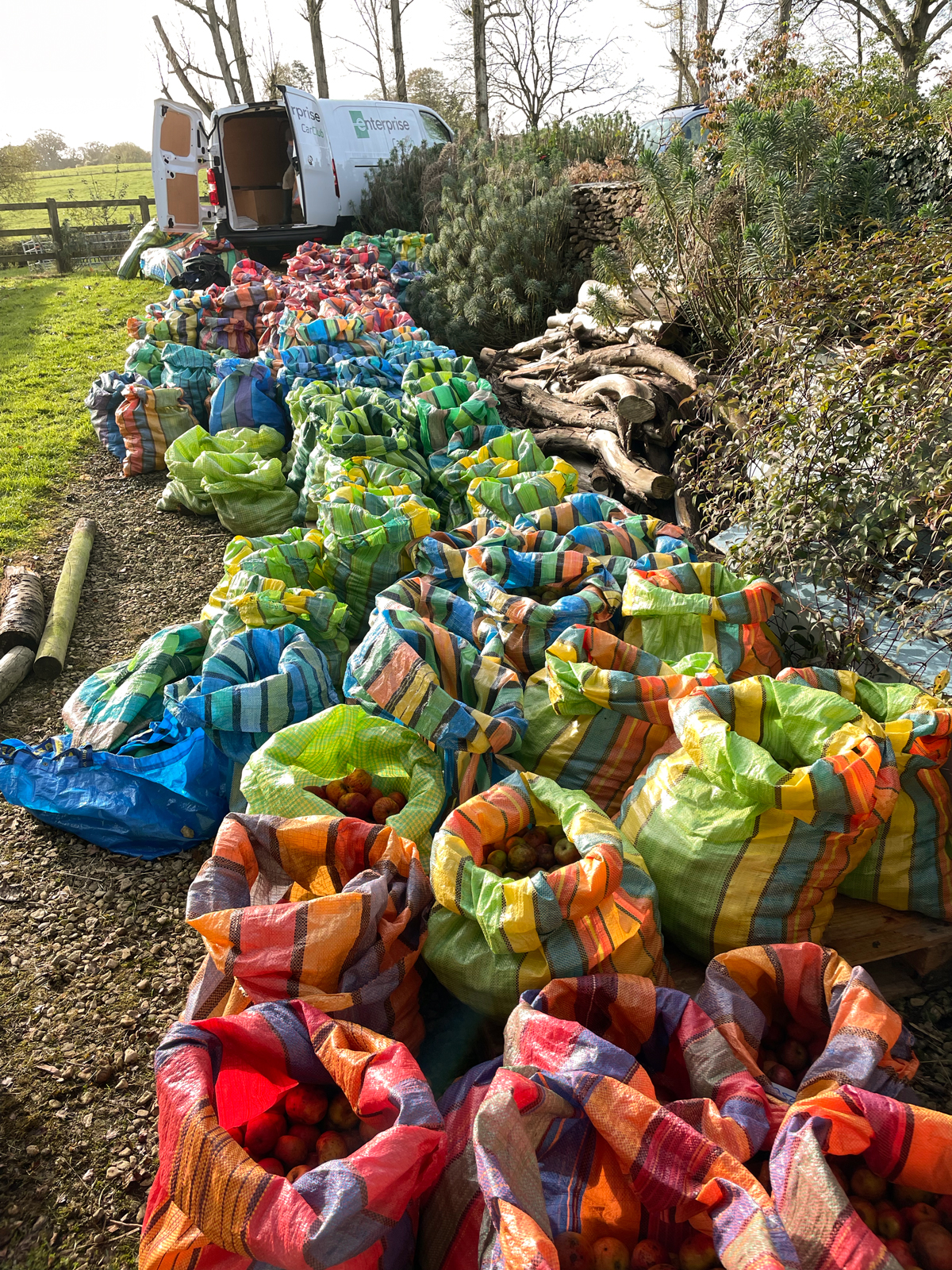


INTRODUCING THE 2021 HARVEST
Our first look at the orchard at Cadbury revealed that many of the trees we rely upon to bear fruit were having an ‘off-year’ [essentially in recuperation mode after a heavy yield in 2020]. This meant we were looking pretty thin on the ground with some varieties [particularly Yarlington Mill, which can slip into biennial fruiting cycles if unpruned]. Happily for us, our early days of cidermaking saw us begging and borrowing fruit from any willing neighbour, farmer or in some cases even back gardens, and so with a little luck were able to scrape together the right proportion of fruit to sustain the 3 main blends – Farmhouse, Orchard and Seymour. This did mean that, unlike 2020, we were going to be making cider with a combination of orchards [except Orchard Blend of course]. We were really interested to find out if we could still make blends that had the same strong sense of character, given that our ingredients were changing. How would this contrast with 2020, where fruit was all from the illustrious orchard at Cadbury? The Winter of 2021 was also comparatively mild. How would this affect fermentation and the finished ciders?

Scrumping Yarlington Mill from a garden orchard at North Cheriton
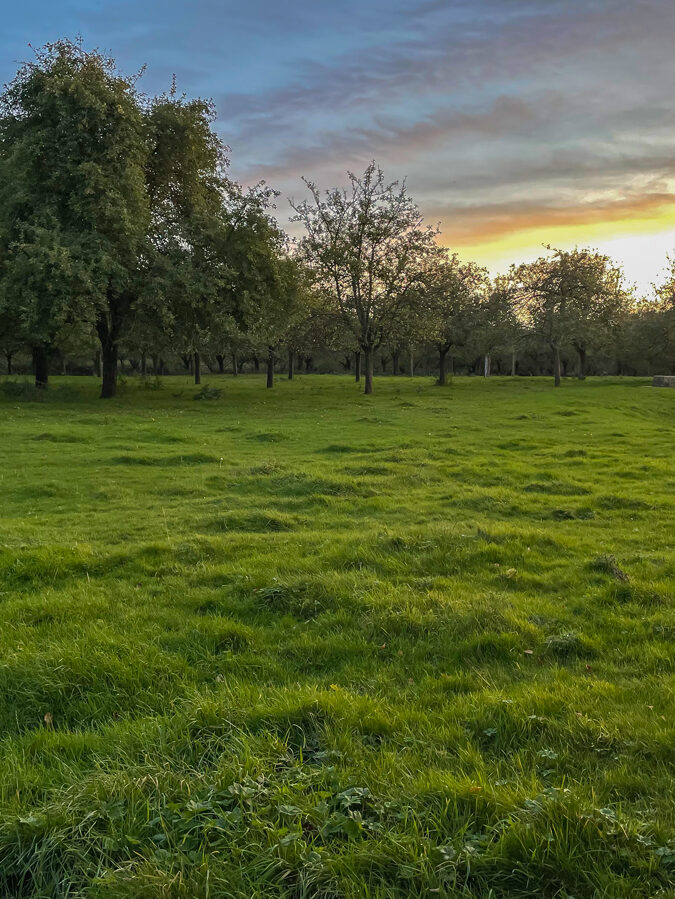
The majestic orchard at North Cadbury from which most of Bratton Seymour fruit comes
BUBBLE BUBBLE BOIL AND TROUBLE
We have come to realise the usefulness of having a few different ciders bubbling away, each made from different varieties, rather than one or two bigger blends. But by dividing our juices into different blends, we ensure that we will always have some cider that is good enough to bottle, even if things don’t go quite to plan. Until now, we have been lucky enough to make a range of ciders that the cover sweet, medium and dry spectrum and so there’s always something for everyone too.
Alas! It looked like we’re in for a fast run this year. The fruit differed considerably across the board in comparison to 2020. Juices were brighter in colour and leaner in structure, less concentrated in general, less sweet in the beginning. We were very happy to get the fruit that we could, but were uncomfortable from the outset that the quality of the finished cider would match the previous vintage.
We do not live close to cider shed and as much as we would like, we are not able to check the tanks every week. Cider is often left unattended for a 4 weeks at a time. In retrospect, this was possibly an error of judgement; it was not until a few weeks after pressing, that the tanks were observed to see whether or not juices have keeved, that we found all were already brothy, with all the signs of a strong fermentation picking up. Not what we would like this early on, as the general rule of thumb goes; fast fermentation = less complexity.
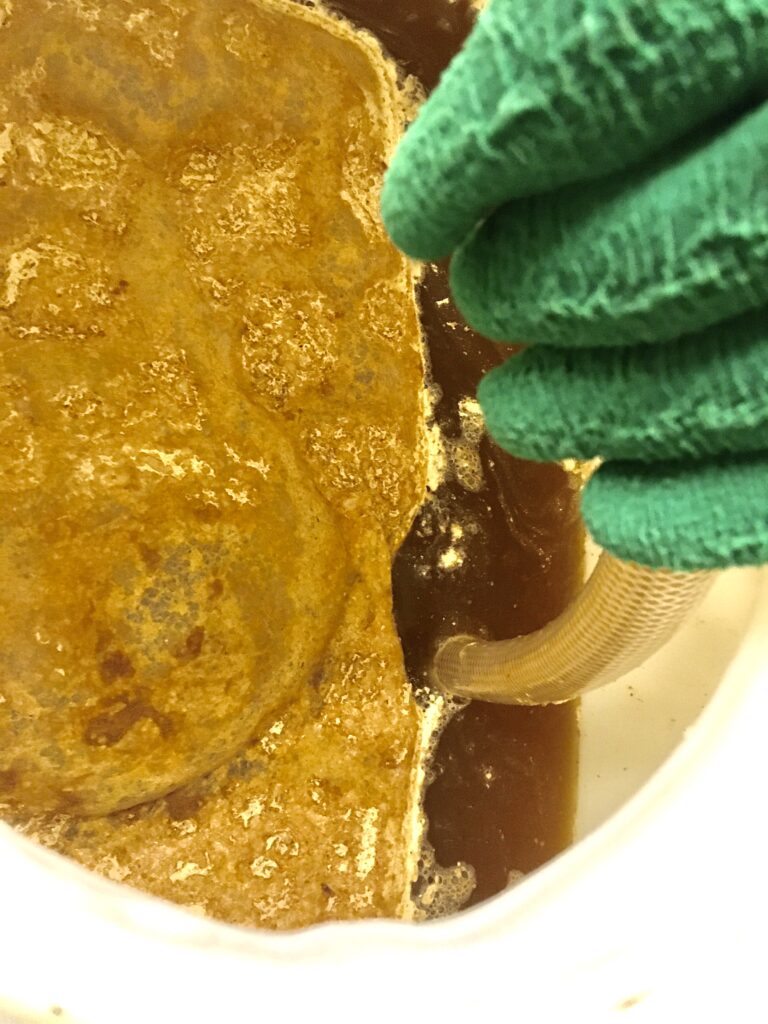
SIDE NOTE This photo shows a successfully keeved cider back in 2020 – with its distinctive floating cap. This occurrence is a natural phenomenon brought about by pectin levels in the unfermented juice, which are broken down by enzymes, into pectin acids that bind with calcium in the juice to form a jelly-like head that rises to the top of the tank.
Here we are extracting the juice from beneath the cap, whilst avoiding any sediment which lies at the bottom. The ‘clear’ juice is transferred to a clean tank and the jelly goes on the compost heap for the birds!
The benefit of keeved cider is the slow pace of fermentation it brings, but also the potential for a more natural sweetness retained in the finished cider. As we would find out later, it can also save a lot of juice from going down the pan!
Given that the keeve on the 2021 vintage had failed – how could we achieve ciders that still had a similar depth of flavour? The only other way one can frustrate the pace of fermentation is through other means is a process known as racking; transferring the juice off it’s lees from one tank into a clean tank, ideally when temperatures are low and yeast deposits settle to the bottom of the tank. We attempted this back in 2019, but clearly it was not properly timed or done with enough frequency, as the final ciders finished dry and a little short for our tastes.
My first look in the tank in January showed that almost 30% of the sugar in the juice had been consumed by the yeast, which was a rather worrying rate! Farmhouse Blend was smelling very reductive at this point [it was, in fact, fairly sulphurous all the way through the process]. If left unchecked we’d be in for more dry and short-tasting cider this year. So I determined to rack sooner and more frequently than we would ever consider doing previously, no matter what the consequences [it is said by some that too much air shown to cider can invite disaster]. Certainly in the case of the heavily reductive Farmhouse Blend, we felt this temporary exposure to oxygen as it passed through the cider pump could even prove beneficial.
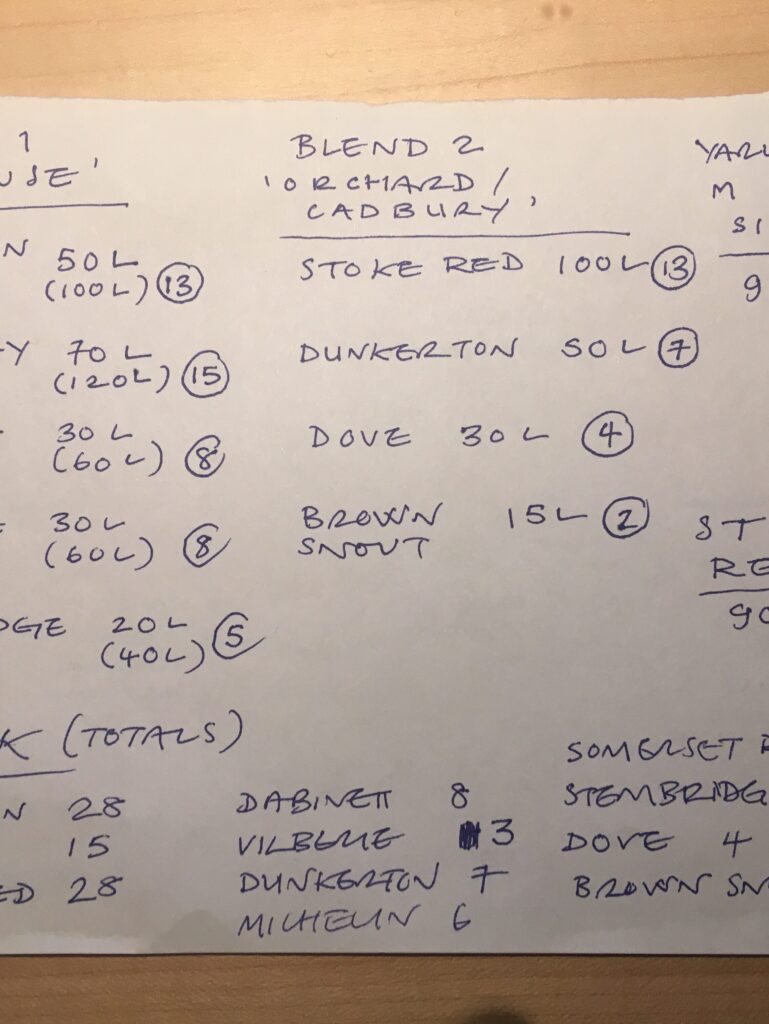
Hastily scribbled blending sheet – varieties and quantities are noted down as they are added
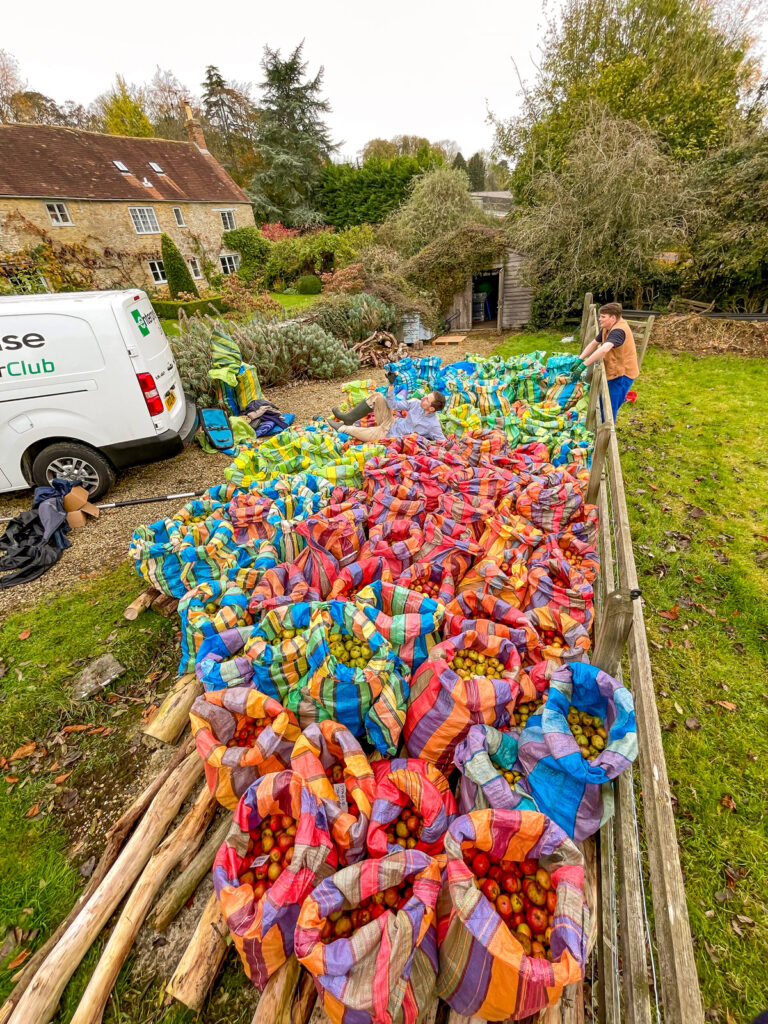
Sacks of different apple varieties outside the cider shed, all arranged by colour
By the March racking [only 2-3 weeks later] fermentation was still strong, but less brisk, and by the April racking things had started to plateau. Despite this encouraging news, by this point the ciders looked to be approaching inevitable dryness. With outside temperatures warming, I was almost 100% sure that they would continue to creep along. But by May’s racking, we were surprised to find that the juices had moved but not a smidgen, and even looked to be stopping, gods be praised!
It’s also worth pointing out that Farmhouse Blend was starting to lose the heavy reduction and some of the fruity aromas were emerging. It seemed the racking process had really done its job; all ciders still had some real complexity retained, and some gentle sweetness to boot. Certainly more than predicted back in March. I had however, not quite bargained for the amount of juice that would be lost to this process; each time the cider is racked, the heavily sedimented juice at the bottom of the tank must be left behind. With successfully keeved cider, less racking is needed, but the 2021 ciders lost as much as 30L per tank, per each rack, so nearly 500L in all! Look out for some delicious cider vinegar in 2023!
One thing we have noticed about the new ciders is their remarkable ability to remain full of zest and dynamism even when open for long periods of time. Some will still be perfectly enjoyable, even one week later [provided the bottle is re-corked]. We think this resilience could in part be due to the ciders prior acclimatisation to oxygen through the racking process, as well as the minute amount of residual sugar retained in the bottle, which sustains a little activity, production of CO2, thus protecting the cider from developing acetic notes.

Designs for the 2021 ciders, which continue the heraldic theme. Farmhouse is always Sun or Moon related, Orchard is always dairy-themed, Seymour Blend takes inspiration from a shell motif emblazoned on the 13th century Norman church at Bratton Seymour. The hand clasping an arrow quotes the Bayeux Tapestry and was designed for a one-off dry, still cider made with Northern French apples planted in the Cadbury Somerset Orchard.
THE 2021 CIDERS

FARMHOUSE BLEND 6.2% ABV
Dry, sparkling
Yarlington Mill, Dabinett, Somerset Redstreak, Dove, Brown Snout & Cadbury Redwing
The theme of Farmhouse Blend continues on from 2019 – a blend of lots of varieties [often odds and ends], but primarily comprising of local apple Yarlington Mill. To us ‘tis the dame of Somerset cider apples, with its pink skin, red flushing and distinctive conical heart shape.
The yearly fluctuations witnessed by apple trees is encapsulated in the fruit they bear and the mystery of this is what interests us most about cidermaking. In 2020 the pressed juice from Yarlington Mill ran a surprisingly rich, treacled, stout-like colour. In 2021, however, the juice was lighter with an amber-reddish tinge. It’s flavour was more fresh-apple than the medicinal notes carried in the previous vintage.
This year’s Farmhouse Blend is, light, fruity with an immediate freshness and vichy-water like carbonation.
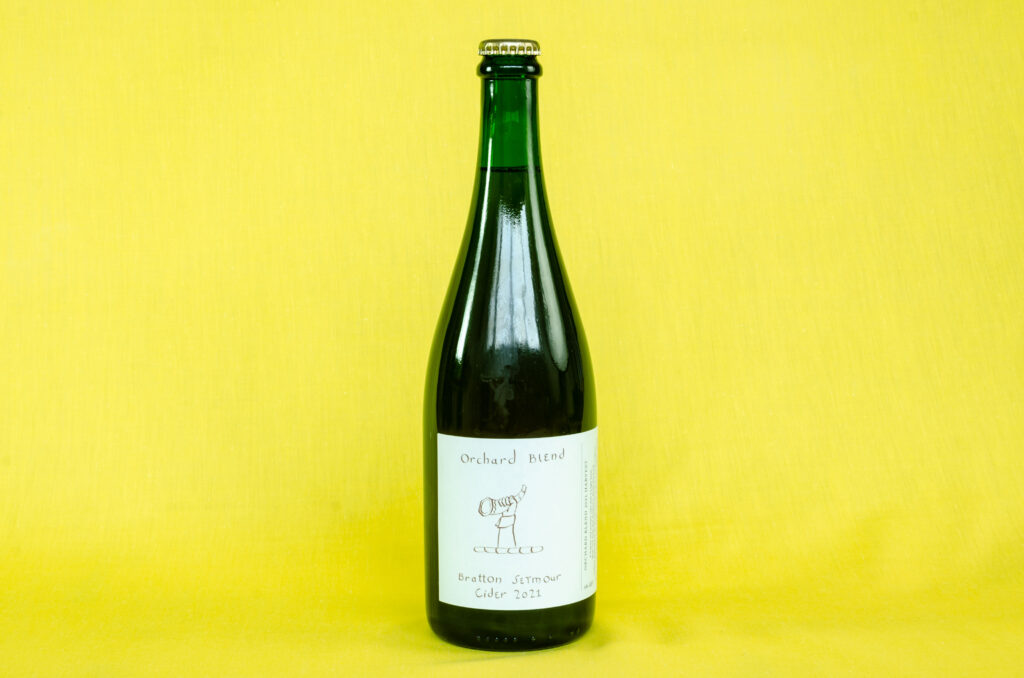
ORCHARD BLEND 6% ABV
Off-dry, sparkling
Mostly Stoke Red, Dunkerton, Brown Snout & Cadbury Redwing
The idea behind Orchard Blend is that it should celebrate the specific characteristics of a single orchard. The fruit is exclusively from Jamie Montgomery’s orchard at Cadbury near Camelot [Jamie makes of one of the last traditional raw milk Cheddars in Somerset]. The orchard boasts 11 varieties and sometimes it’s hard to know where to start picking! Jamie mentioned he’d never tried a cider made solely from his orchard and we liked the idea of this as a starting point. We chose apples that really stood out; Stoke Red for the main part of the blend [a vintage sharp apple], the aptly named Brown Snout for tannin and aromatics, Dunkerton for it’s round genteel sweetness and a Cadbury Redwing, an unknown variety unique to this orchard, for a little sharp freshness.
It’s the most elegant of our 2021 ciders and you can really taste the flavour borne out by each variety. We are particularly pleased with the bubbles, which are lovely and fine.
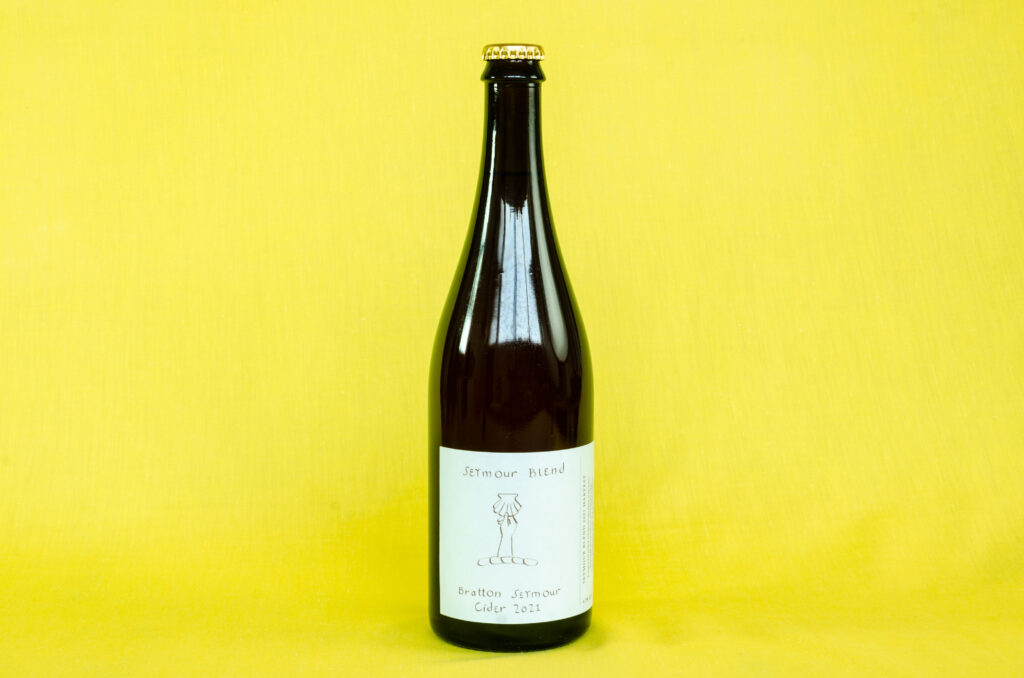
SEYMOUR BLEND 6.4% ABV
Off-dry, sparkling
Michelin, Stembridge Jersey & Vilberie from the orchard at North Cadbury blended with eating apples from Bratton Seymour.
We thought it would be fun to make a blend that was a nod to the heritage of the village, Bratton Seymour, where our small cider production is based. ‘Seymour’ is rumoured to be a corruption of the French ‘Saint-Maur’ and we liked the idea of using apples that originally hailed from France, were grown in Somerset and married with Somerset apples in the tank. It’s a brave cider, with a full bittersweet astringency we find toothsome, quaffable and very much at home in Somerset.
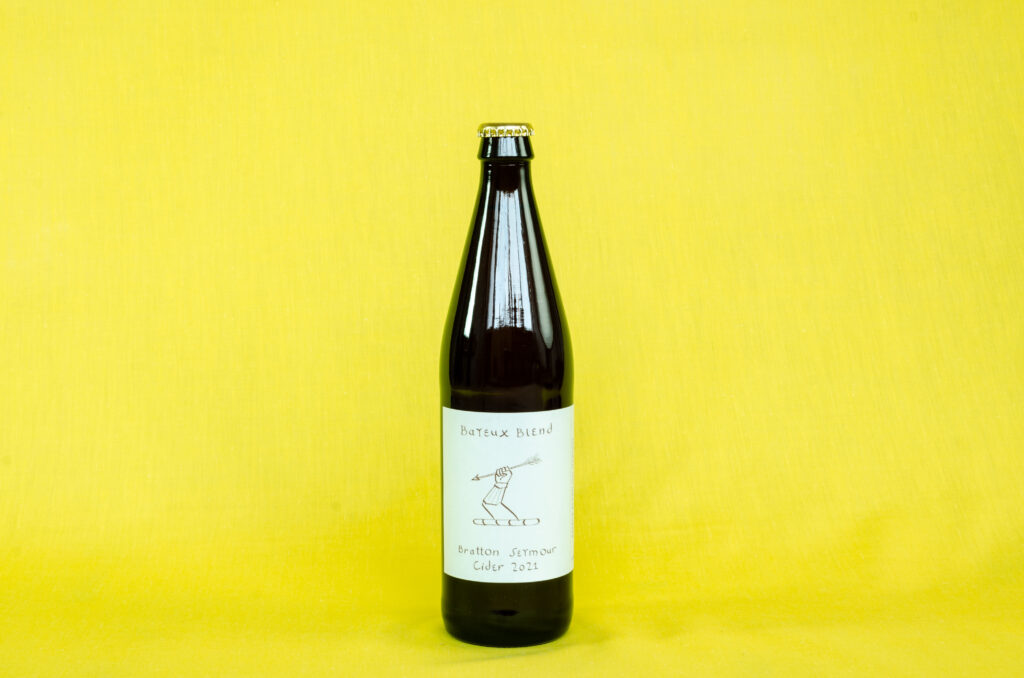
BAYEUX BLEND 6.6% ABV
Dry, still
An aromatic, blend of apples from four orchards. It has pronounced stemmy tannins and a heady apple-y finish.
Inspired by the famous Bayeux Tapestry, we blended apples from a Normandy variety, which were widely planted in Somerset in the 70s, with 10 other local varieties such as Redstreak, Dabinett & Stembridge Jersey. Because this cider is dry with stemmy, leafy tannins we recommend drinking it with food.
Try our delicious 2021 ciders today
-
 BAYEUX 2021 – 6.6% DRY – 3 BOTTLES£19,00
BAYEUX 2021 – 6.6% DRY – 3 BOTTLES£19,00 -
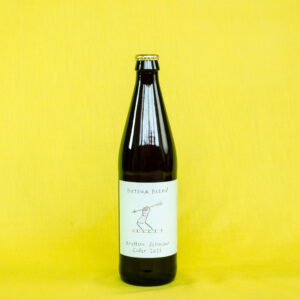 BAYEUX 2021 – 6.6% DRY£7,00
BAYEUX 2021 – 6.6% DRY£7,00
